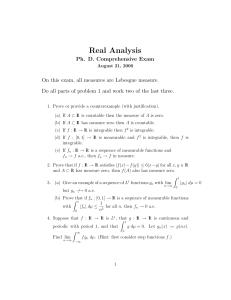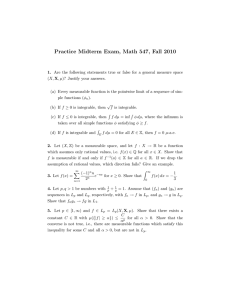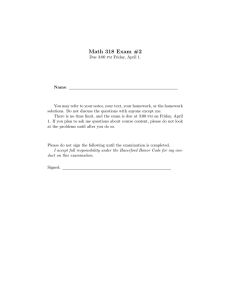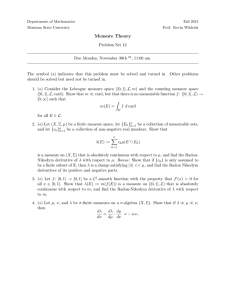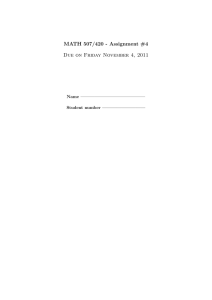Math 617 HW #3
advertisement
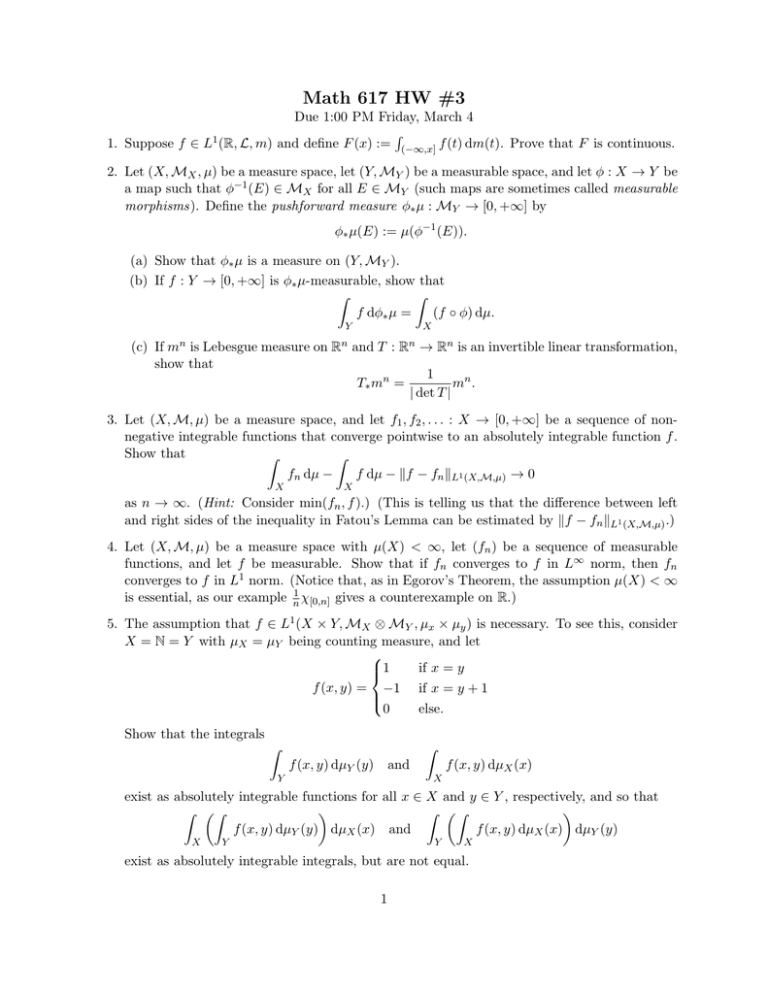
Math 617 HW #3
Due 1:00 PM Friday, March 4
R
1. Suppose f ∈ L1 (R, L, m) and define F (x) := (−∞,x] f (t) dm(t). Prove that F is continuous.
2. Let (X, MX , µ) be a measure space, let (Y, MY ) be a measurable space, and let φ : X → Y be
a map such that φ−1 (E) ∈ MX for all E ∈ MY (such maps are sometimes called measurable
morphisms). Define the pushforward measure φ∗ µ : MY → [0, +∞] by
φ∗ µ(E) := µ(φ−1 (E)).
(a) Show that φ∗ µ is a measure on (Y, MY ).
(b) If f : Y → [0, +∞] is φ∗ µ-measurable, show that
Z
Z
(f ◦ φ) dµ.
f dφ∗ µ =
X
Y
(c) If mn is Lebesgue measure on Rn and T : Rn → Rn is an invertible linear transformation,
show that
1
T∗ mn =
mn .
| det T |
3. Let (X, M, µ) be a measure space, and let f1 , f2 , . . . : X → [0, +∞] be a sequence of nonnegative integrable functions that converge pointwise to an absolutely integrable function f .
Show that
Z
Z
fn dµ −
f dµ − kf − fn kL1 (X,M,µ) → 0
X
X
as n → ∞. (Hint: Consider min(fn , f ).) (This is telling us that the difference between left
and right sides of the inequality in Fatou’s Lemma can be estimated by kf − fn kL1 (X,M,µ) .)
4. Let (X, M, µ) be a measure space with µ(X) < ∞, let (fn ) be a sequence of measurable
functions, and let f be measurable. Show that if fn converges to f in L∞ norm, then fn
converges to f in L1 norm. (Notice that, as in Egorov’s Theorem, the assumption µ(X) < ∞
is essential, as our example n1 χ[0,n] gives a counterexample on R.)
5. The assumption that f ∈ L1 (X × Y, MX ⊗ MY , µx × µy ) is necessary. To see this, consider
X = N = Y with µX = µY being counting measure, and let
if x = y
1
f (x, y) = −1 if x = y + 1
0
else.
Show that the integrals
Z
Z
f (x, y) dµY (y)
and
Y
f (x, y) dµX (x)
X
exist as absolutely integrable functions for all x ∈ X and y ∈ Y , respectively, and so that
Z Z
Z Z
f (x, y) dµY (y) dµX (x) and
f (x, y) dµX (x) dµY (y)
X
Y
Y
X
exist as absolutely integrable integrals, but are not equal.
1
6. Let (X, M, µ) be a σ-finite measure space and let f : X → [0, +∞] be measurable. Recall
that BR is the Borel σ-algebra on R and m is Lebesgue measure on R. Show that
(a) the set A = {(x, t) ∈ X × R : 0 ≤ t ≤ f (x)} is measurable on M ⊗ BR and
Z
f (x) dµ(x);
(µ × m)(A) =
X
(b) we have
Z
Z
µ(f −1 ([λ, +∞])) dm(λ),
f (x) dµ(x) =
[0,+∞]
X
(When µ is a probability measure, the function inside the right hand side integral is
called the complementary cumulative distribution function.)
Bonus Problem The example in Problem 5 might seem a bit artificial: after all, maybe the
discreteness of the setting is what’s causing the problem. In fact, similar examples always
exist. Give an example of a Borel measurable function f : [0, 1] × [0, 1] → R so that the
integrals
Z
Z
f (x, y) dm(y)
and
[0,1]
f (x, y) dm(x)
[0,1]
exist as absolutely integrable functions for all x ∈ [0, 1] and y ∈ [0, 1], respectively, and so
that
!
!
Z
Z
Z
Z
f (x, y) dm(x) dm(y)
f (x, y) dm(y) dm(x) and
[0,1]
[0,1]
[0,1]
exist as absolutely integrable integrals, but are not equal.
2
[0,1]

